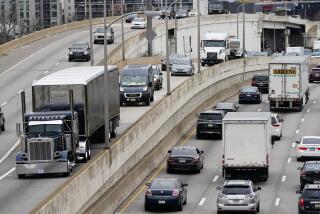Campaign to Tout Vehicle Stability Control System
- Share via
WASHINGTON — A vehicle control system that has been shown by one study in Germany to cut down dramatically on accidents is available on just 6% of vehicles in the United States.
Electronic stability control, a feature on one of every three cars in Europe, has yet to catch on among American drivers.
Many have never heard of it, and that has prompted suppliers to plan an eight-city tour kicking off Wednesday in Washington.
Suppliers of stability control systems say they hope consumer demand, not government mandates, will persuade automakers to overcome their aversion to added costs and offer the system on more vehicles.
Electronic stability control is a system that applies brakes to specific tires and decelerates if it senses a driver is veering off course.
If a driver swerves to the left to avoid an animal in the road, for example, a vehicle with stability control would apply brakes to the outside front tire to prevent the vehicle from fishtailing.
Stability control is different from traction control, which keeps wheels from spinning when the driver accelerates. It’s also different from all-wheel drive, which distributes energy to all four tires.
Stability control was developed in Germany by Bosch Corp. and Mercedes-Benz. It started appearing on luxury vehicles in the mid-1990s. In 1999, Mercedes was the first to make it standard in all its vehicles.
According to a study of German government data released last year by DaimlerChrysler, accident rates for Mercedes vehicles in Germany fell 29% from 1999 to 2000 after stability control became standard.
In 1999, Mercedes vehicles were in 15,000 crashes, whereas in 2000 they were in 10,600 crashes. In 2001, Mercedes vehicles were in 10,700 crashes, the study said. Crash rates for all other vehicles remained steady during that time, the study said.
Spurred by such data, Europe has adopted stability control much faster than the United States.
Some U.S. automakers have quietly responded to European demand. In Germany, stability control is standard on a three-door Ford Focus. In Britain, stability control is a $1,220 option on the same vehicle. In the U.S., it’s a $1,625 option.
Todd Brown, manager of North American brake control products at Ford Motor Co., said his company is simply responding to market demands. But he said automakers could do a better job of marketing the technology to U.S. buyers.
It’s unlikely the federal government would step in and require the technology. National Highway Traffic Safety Administration spokesman Tim Hurd said there was too little U.S. data to determine its effectiveness.
NHTSA chief Jeffrey Runge will attend Wednesday’s event, but he won’t be speaking or officially endorsing the product, his office said.
He told a Senate committee this year that he believed automakers would voluntarily add stability control once NHTSA began a new kind of crash test that would measure vehicle performance in sharp turns. Those tests are expected to begin next year.
For now, the price of stability control varies widely, and it’s often included only in luxury packages.
R. David Pittle, senior vice president for technical policy at Consumers Union, which publishes Consumer Reports, said consumer demand could soar when NHTSA starts publishing results of new crash tests.
General Motors Corp. spokesman Jim Schell said automakers would have to spend years figuring out how to integrate stability control in their vehicles.
“It’s not something you can just attach onto a vehicle and hope it works,” Schell said.






